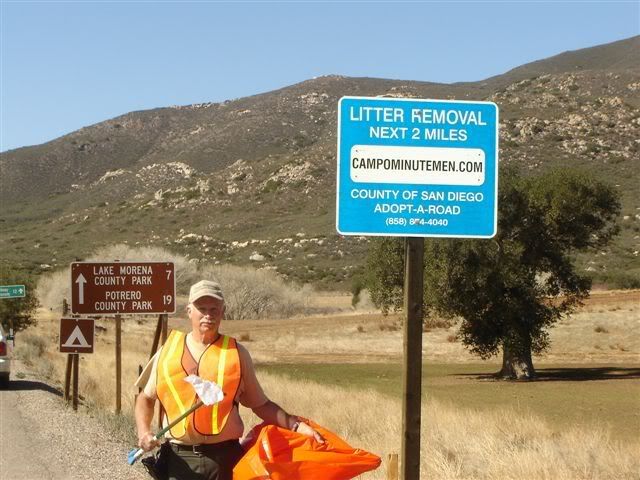If anyone is interested in highway / illegal alien clean up, the weekend of July 4th, or anytime, please contact
Dan at drussell9@AOL.COM
------------------------------------------------
I wish the MCDC and other folks well on their July 3rd. - 6th.
operations. With 2500 members just in California, do you think 5 or 6
of them would help us with litter removal along Buckman Springs Rd.?
We could even try and clean up some of the invading trails leading from
Buchman Springs Rd. towards I-8? Maybe even focus on cleaning up that
huge layover spot that Jerimia spl.? found South of the High school and
West of Buckman Springs Rd.?
Yesterday, Lighteningrod and I removed another three orange bags (90 Gal.) of litter from Buckman Springs Rd.
It looked like the Border Patrol busted (within past 24 hrs.) a group of illegal
aliens right at the intersection of Oak Rd. and Buckman Springs Rd.
We found and removed 4 to 5 white cuffs the Border Patrol uses, plus, picked up 4
to 5 tooth brushes and tooth paste tubes. Just wish the Border Patrol would get
in the habit of picking up their plastic cuff's when they are returning
to the stations. I find them used as trail markers sometimes.
Dan.
-
Saturday, May 31, 2008
Monday, May 26, 2008
Camp Minutemen Highway Clean up And Border Light Up Memorial Day 5/08
Campo Minutemen Cleaned up Buckman Springs Road, removing 200 gallons of trash. They had a BBQ dinner at 141 and lit up Smith Canyon - old time Minutemen will remember lighting up Smith Canyon in the summer of 2005.
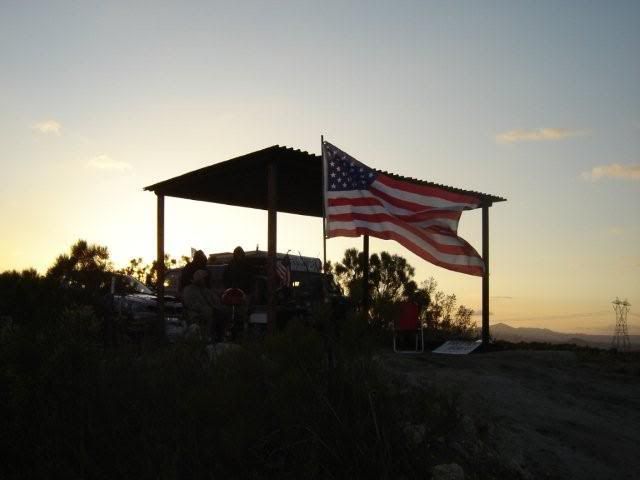
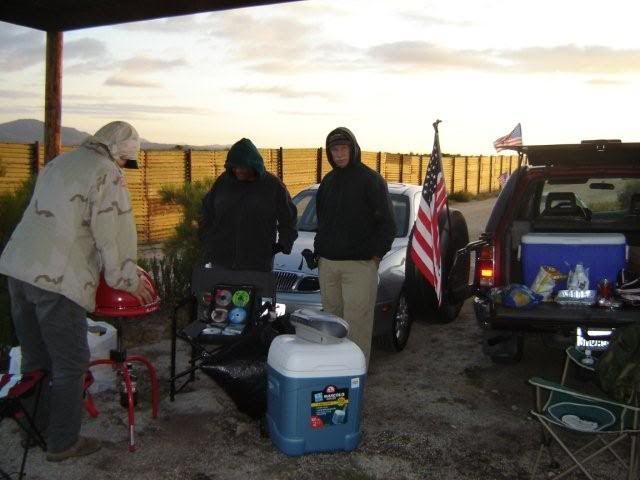

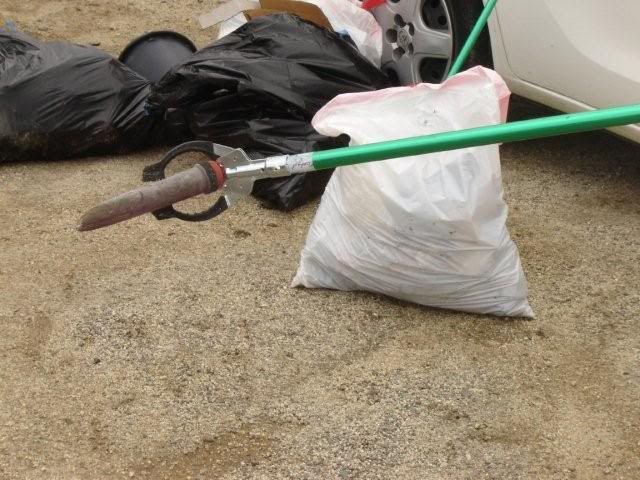
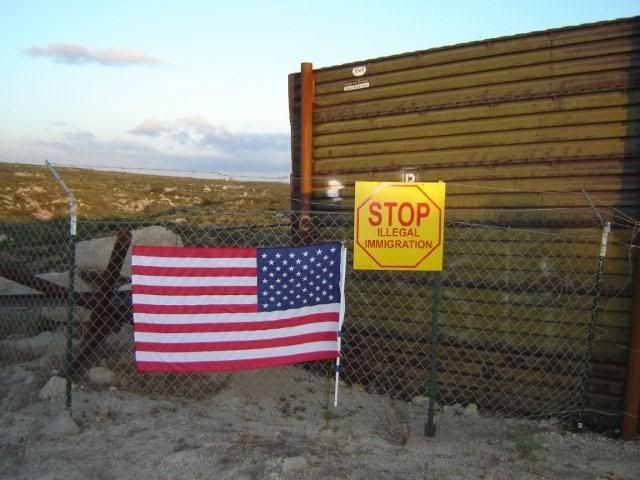
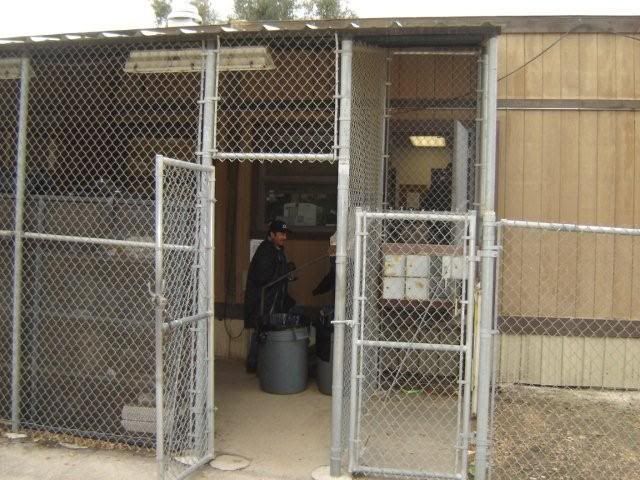
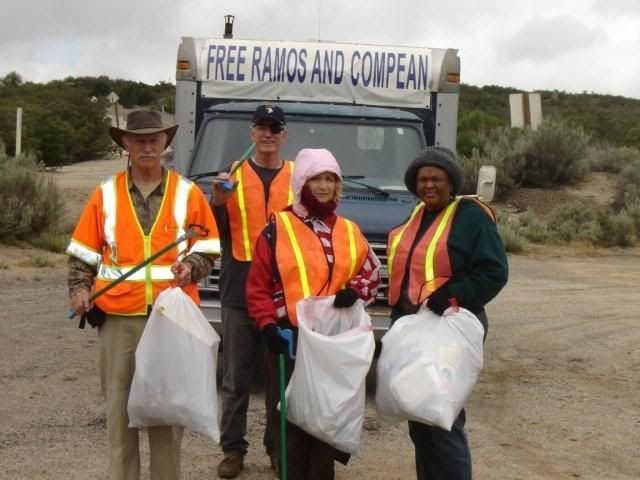
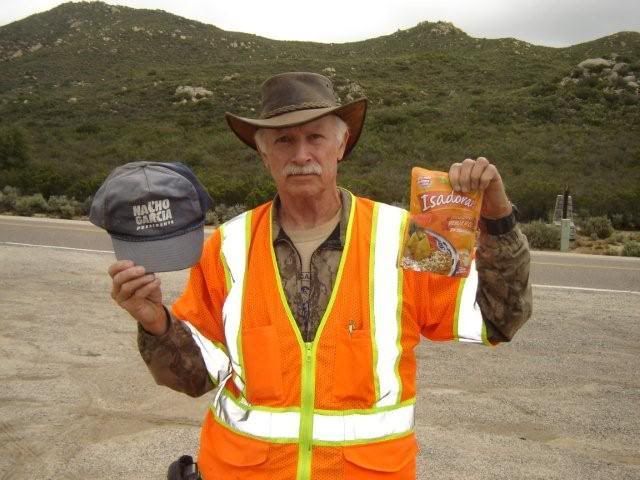








Report from G - Man - 337 apprehended this year
It has been very busy over here ,at least two groups every 24 hrs and sometimes three to four with six to 18 per group.
I'm not getting much sleep because they are coming through at all hours. In the last 24 hours alone we have apprehended 47. My year to date is now 337, yet the news says apprehensions are down. Who are you going to believe?
I'm not getting much sleep because they are coming through at all hours. In the last 24 hours alone we have apprehended 47. My year to date is now 337, yet the news says apprehensions are down. Who are you going to believe?
Saturday, May 17, 2008
Razor-sharp concertina wire installed at U.S.-Mexico border
http://www.latimes.com/news/local/la-me-wire17-2008may17,0,5295630.story
Don Bartletti / Los Angeles Times
U.S. Border Patrol agent Richard Smith drives Wednesday along a section of the border fence in San Ysidro that was recently topped with razor wire.
SAN DIEGO -- — The U.S. Border Patrol is installing razor-sharp concertina wire atop border fencing between San Diego and Tijuana, marking a major shift in approach along a frequently violent stretch of the frontier.
The triple-strand wire, meant to keep smugglers from attacking agents, will stretch five miles when completed this summer -- the longest expanse of this type of wire ever used on the Southwest border.
Federal authorities in the past have avoided using fortifications with such negative symbolism. Hundreds of miles of barriers going up in other areas have had to meet "aesthetically pleasing" federal design standards.
Critics say the new approach is inhumane and could leave illegal immigrants bloodied.
Border officials in San Diego say it was necessary and already is proving effective.
They say they opted to augment the existing fencing with razor wire amid escalating violence across from Colonia Libertad, one of Tijuana's most notorious smuggling enclaves.
The hilly area, roughly between the San Ysidro and Otay Mesa ports of entry, is already one of the most heavily fortified along the Southwest border, with primary and secondary fences, stadium lighting and camera towers.
The area has been the scene of frequent clashes between rock-throwing youths and agents firing pepper spray and tear gas. Despite using tear gas to disperse attackers and improving cooperation with Mexican authorities, U.S. authorities are still being attacked, said San Diego's Chief Patrol Agent Michael J. Fisher.
Fisher drew criticism late last year after his agents began tear-gassing densely populated areas, sending some residents to a hospital. He said the safety of his agents is his top priority.
"We didn't just decide to put up concertina wire," Fisher said. "This is a 1.5-year process on . . . how to make the border safe and secure, and to keep our agents safe from assaults."
So far, about a mile of the concertina wire is up. The installation started in December for a 60-day test period and was expanded in February. The wire runs atop the secondary fence, which sits roughly 50 yards inside the primary fence.
According to the Border Patrol, there were half as many assaults in the five months since the wire went up -- 58, compared with 122 in the five months before the installation.
Illegal entries were also down more than 50% over the same period, from 16,322 to 6,319, according to Border Patrol statistics.
Immigrant rights groups call the new fencing a major move toward border militarization. They say it's not the right solution.
"This is a primitive way of trying to conduct border enforcement," said Pedro Rios, San Diego area program director for the American Friends Service Committee. "Razor-sharp wire isn't going to stop people from coming across, and I doubt it will stop people from throwing rocks."
Enrique Morones, president of the Border Angels, a San Diego-based immigrant rights group, said he thought it would push more illegal immigrants into dangerously remote desert and mountain areas.
"This fence shows a total disregard for human life," said Morones. "What's next? Gun racks with machine guns and bazookas?"
The new tactics are praised by foes of illegal immigration, who frequently call for stricter enforcement. "This is a fence that is in plain view," said Steven Camarota, director of research for the Center for Immigration Studies, which favors curbs on immigration. "One has to keep in mind that the illegal alien trying to enter the U.S. is responsible for his own actions."
Border Patrol officials said they have tried to minimize the dangers of the new wire by lighting the area at night and erecting warning signs in Spanish. They predict that the wire will reduce injuries by serving as a deterrent. In the past, many immigrants have injured legs and ankles jumping from the 17-foot-high barriers.
Since the first concertina wire went up, only one immigrant has been injured by it, officials said. He got tangled up in the wire and was treated for minor injuries and returned to Mexico, officials said.
Concertina wire and regular barbed wire have been used on a limited basis in the past, mostly to fortify ports of entry and other federal facilities along the border. Most of the border fencing going up this year is made of welded wire or steel tubes without any sharp edges.
Fences topped with concertina wire have proved tough to breach, authorities say. Smugglers have tried without success to rip down the new wire by chaining it to a moving car.
Fisher, the Border Patrol chief, said he won't give an inch.
The fence, he said, sends a strong message to smuggling groups that threaten his agents:
"It will be a long battle unless we can show the smugglers that we won't cede the area. Nor will we retreat our position further to the north, and allow them to operate with impunity."
richard.marosi@latimes.com
Don Bartletti / Los Angeles Times
U.S. Border Patrol agent Richard Smith drives Wednesday along a section of the border fence in San Ysidro that was recently topped with razor wire.
SAN DIEGO -- — The U.S. Border Patrol is installing razor-sharp concertina wire atop border fencing between San Diego and Tijuana, marking a major shift in approach along a frequently violent stretch of the frontier.
The triple-strand wire, meant to keep smugglers from attacking agents, will stretch five miles when completed this summer -- the longest expanse of this type of wire ever used on the Southwest border.
Federal authorities in the past have avoided using fortifications with such negative symbolism. Hundreds of miles of barriers going up in other areas have had to meet "aesthetically pleasing" federal design standards.
Critics say the new approach is inhumane and could leave illegal immigrants bloodied.
Border officials in San Diego say it was necessary and already is proving effective.
They say they opted to augment the existing fencing with razor wire amid escalating violence across from Colonia Libertad, one of Tijuana's most notorious smuggling enclaves.
The hilly area, roughly between the San Ysidro and Otay Mesa ports of entry, is already one of the most heavily fortified along the Southwest border, with primary and secondary fences, stadium lighting and camera towers.
The area has been the scene of frequent clashes between rock-throwing youths and agents firing pepper spray and tear gas. Despite using tear gas to disperse attackers and improving cooperation with Mexican authorities, U.S. authorities are still being attacked, said San Diego's Chief Patrol Agent Michael J. Fisher.
Fisher drew criticism late last year after his agents began tear-gassing densely populated areas, sending some residents to a hospital. He said the safety of his agents is his top priority.
"We didn't just decide to put up concertina wire," Fisher said. "This is a 1.5-year process on . . . how to make the border safe and secure, and to keep our agents safe from assaults."
So far, about a mile of the concertina wire is up. The installation started in December for a 60-day test period and was expanded in February. The wire runs atop the secondary fence, which sits roughly 50 yards inside the primary fence.
According to the Border Patrol, there were half as many assaults in the five months since the wire went up -- 58, compared with 122 in the five months before the installation.
Illegal entries were also down more than 50% over the same period, from 16,322 to 6,319, according to Border Patrol statistics.
Immigrant rights groups call the new fencing a major move toward border militarization. They say it's not the right solution.
"This is a primitive way of trying to conduct border enforcement," said Pedro Rios, San Diego area program director for the American Friends Service Committee. "Razor-sharp wire isn't going to stop people from coming across, and I doubt it will stop people from throwing rocks."
Enrique Morones, president of the Border Angels, a San Diego-based immigrant rights group, said he thought it would push more illegal immigrants into dangerously remote desert and mountain areas.
"This fence shows a total disregard for human life," said Morones. "What's next? Gun racks with machine guns and bazookas?"
The new tactics are praised by foes of illegal immigration, who frequently call for stricter enforcement. "This is a fence that is in plain view," said Steven Camarota, director of research for the Center for Immigration Studies, which favors curbs on immigration. "One has to keep in mind that the illegal alien trying to enter the U.S. is responsible for his own actions."
Border Patrol officials said they have tried to minimize the dangers of the new wire by lighting the area at night and erecting warning signs in Spanish. They predict that the wire will reduce injuries by serving as a deterrent. In the past, many immigrants have injured legs and ankles jumping from the 17-foot-high barriers.
Since the first concertina wire went up, only one immigrant has been injured by it, officials said. He got tangled up in the wire and was treated for minor injuries and returned to Mexico, officials said.
Concertina wire and regular barbed wire have been used on a limited basis in the past, mostly to fortify ports of entry and other federal facilities along the border. Most of the border fencing going up this year is made of welded wire or steel tubes without any sharp edges.
Fences topped with concertina wire have proved tough to breach, authorities say. Smugglers have tried without success to rip down the new wire by chaining it to a moving car.
Fisher, the Border Patrol chief, said he won't give an inch.
The fence, he said, sends a strong message to smuggling groups that threaten his agents:
"It will be a long battle unless we can show the smugglers that we won't cede the area. Nor will we retreat our position further to the north, and allow them to operate with impunity."
richard.marosi@latimes.com
Wednesday, May 14, 2008
Campo Minuteman Gets A Radio Show
email Dave at :
true_son_of_liberty@yahoo.com
Dave here(magnum). I finally got my Radio show up and running. I am on
http://www.firstamendmentradio.com/
every Tuesday and Wednesday for now at 11 am. We have affiliates across America but many in Texas and Florida and a few here in the Fresno area. We are also on Satellite and of course the internet.
559 781 3553 is the studio number.
Dave
true_son_of_liberty@yahoo.com
true_son_of_liberty@yahoo.com
Dave here(magnum). I finally got my Radio show up and running. I am on
http://www.firstamendmentradio.com/
every Tuesday and Wednesday for now at 11 am. We have affiliates across America but many in Texas and Florida and a few here in the Fresno area. We are also on Satellite and of course the internet.
559 781 3553 is the studio number.
Dave
true_son_of_liberty@yahoo.com
Wednesday, May 7, 2008
Border fence across deep canyon will begin to be built next month
http://www.signonsandiego.com/news/mexico/tijuana/20080507-9999-1n7gulch.html
May 7, 2008
More than two years after a precedent-setting move by the federal government cleared a path around environmental laws and legal challenges, the construction of a stretch of border fence across a deep canyon known as Smuggler's Gulch is set to begin next month.
Proposed additional fencing
The project will require cutting earth from surrounding hills and filling in the canyon with more than 2 million cubic yards of dirt, an operation so large that critics fear disastrous environmental consequences.
According to the latest plans from the U.S. Customs and Border Protection, the project will consist of constructing an earthen berm across the canyon to support a 15-foot secondary steel-mesh fence and all-weather patrol and access roads.
The agency said a $48.6 million contract was awarded this year to the Keiwit Corp., a construction and mining firm based in Omaha, Neb.
Elsewhere along the U.S.-Mexico border, fence construction has ranged from about $2 million to a little more than $3 million per mile, he said.
“Certainly in some areas, it is easier to construct than it is in others,” said Barry Morrissey, a spokesman with U.S. Customs and Border Protection in Washington, D.C. “Just based on the geography there, this particular segment posed some unusual challenges.”
The terrain is what concerns the critics, who fear that sediment from the project will harm the Tijuana River estuary, where millions in state and federal tax dollars have been spent to restore wetlands.
The fence in the Smuggler's Gulch area west of the San Ysidro port of entry will stretch for about 3.5 miles. More fencing to the east and west of that segment will add another mile. Combined, the new fencing will complete a 14-mile run of contiguous secondary fence running inland from the Pacific.
In February 2004, several environmental groups, including the Sierra Club and the San Diego Audubon Society, filed suit in federal court to stop the project. The same month, the California Coastal Commission stalled construction after ruling that it would cause environmental damage.
The following year, however, federal legislation granted the Department of Homeland Security the authority to waive all laws and litigation standing in the way of fence construction. In September 2005, Homeland Security Secretary Michael Chertoff set a precedent by exercising the waiver authority in San Diego.
In December of that year, the lawsuit was thrown out of court; later that month, a federal judge in San Diego ruled that the waiver authority was not unconstitutional.
Since then, as the federal government rushes to have 670 miles of pedestrian and vehicle fencing in place by the end of this year under the 2005 Secure Border Initiative, the department has waived environmental and other restrictions impeding construction elsewhere, starting last year in Arizona.
On April 1, two additional waivers cleared the way for fence construction in California, Arizona, New Mexico and Texas, with one waiver encompassing roughly 470 total miles.
Meanwhile, National Guard troops in San Diego County have been doing preliminary construction along the border, including building access roads.
As construction approaches Smuggler's Gulch, environmentalists are trying to find last-minute ways to reduce the environmental impact, especially sediment damage to the estuary at Border Field State Park.
“When you put a lot of sediment into an estuary, it changes the function and structure of the estuary, until it compromises the function,” said Mike McCoy of the Southwest Wetlands Interpretive Association, a plaintiff in a 2004 suit.
McCoy and representatives from the local Audubon Society, the Save Our Heritage Organisation and other groups met last week with Rep. Bob Filner, D-San Diego, to discuss a draft of an alternative fence and border security plan.
The alternative proposal would involve spending $70 million for fence construction to instead replace the existing primary fence – there is older fencing at the bottom of the gulch – with a sturdier one. It also calls for hiring additional Border Patrol agents, dedicating money toward agent housing, improving existing border roads and providing enhanced sensor technology.
Smuggler's Gulch gets its name in part from liquor smuggling from Mexico during Prohibition, said Border Patrol Agent Jason Rodgers. While agents have seen increased human-and drug-smuggling traffic there in recent months, including a recent large marijuana seizure, “I wouldn't say it's one of our worst areas,” Rodgers said.
Nonetheless, the Smuggler's Gulch fence is necessary for border security, said Rep. Duncan Hunter, R-Alpine, a longtime proponent of the project who championed the waiver authority in Congress.
“If we are really going to have an effect on controlling our border, we can't be having eight-to 10-year delays on these really small sections,” Hunter said. “I think we actually waited a full year on a study to see if the gnatcatcher would fly over the fence. While we were analyzing that, tons of cocaine were coming over that border.”
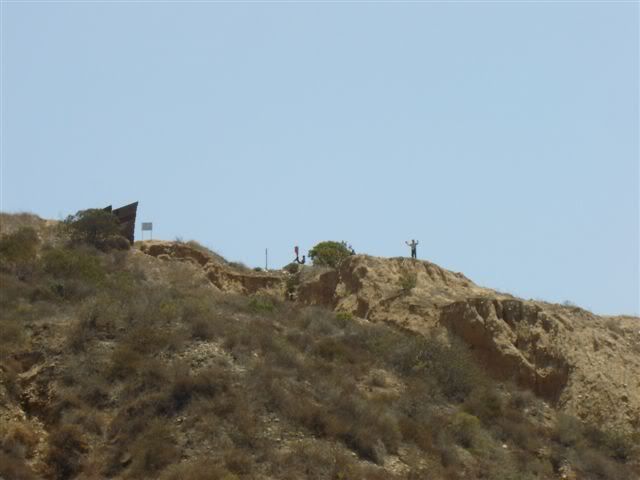


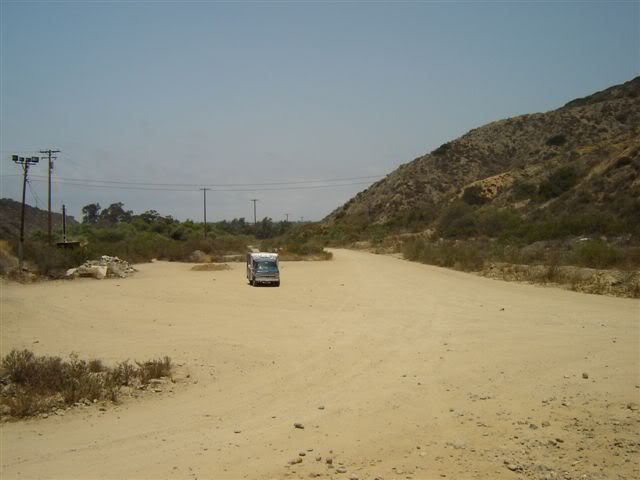
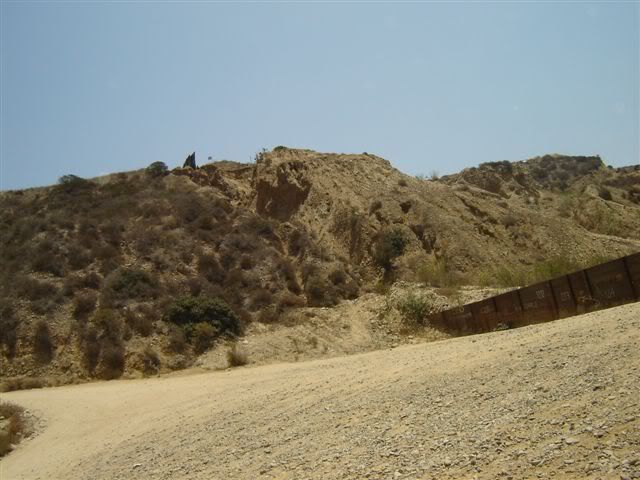
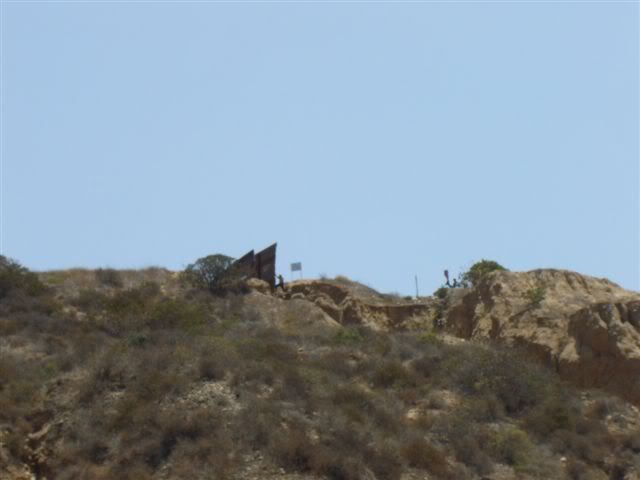
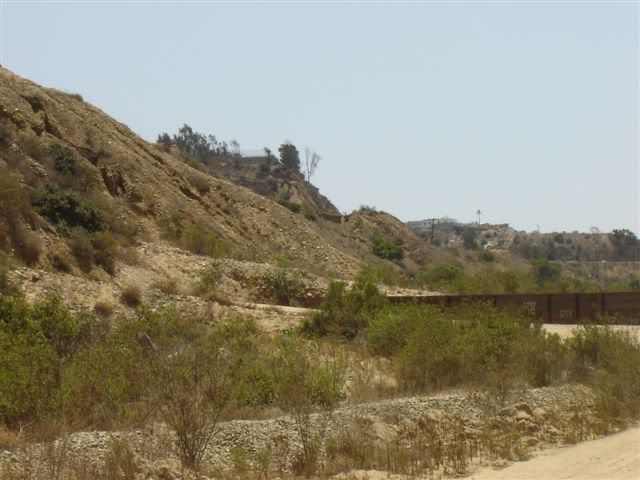
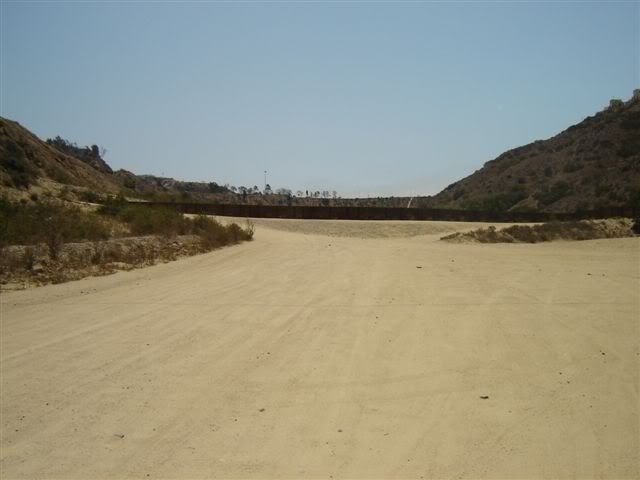
May 7, 2008
More than two years after a precedent-setting move by the federal government cleared a path around environmental laws and legal challenges, the construction of a stretch of border fence across a deep canyon known as Smuggler's Gulch is set to begin next month.
Proposed additional fencing
The project will require cutting earth from surrounding hills and filling in the canyon with more than 2 million cubic yards of dirt, an operation so large that critics fear disastrous environmental consequences.
According to the latest plans from the U.S. Customs and Border Protection, the project will consist of constructing an earthen berm across the canyon to support a 15-foot secondary steel-mesh fence and all-weather patrol and access roads.
The agency said a $48.6 million contract was awarded this year to the Keiwit Corp., a construction and mining firm based in Omaha, Neb.
Elsewhere along the U.S.-Mexico border, fence construction has ranged from about $2 million to a little more than $3 million per mile, he said.
“Certainly in some areas, it is easier to construct than it is in others,” said Barry Morrissey, a spokesman with U.S. Customs and Border Protection in Washington, D.C. “Just based on the geography there, this particular segment posed some unusual challenges.”
The terrain is what concerns the critics, who fear that sediment from the project will harm the Tijuana River estuary, where millions in state and federal tax dollars have been spent to restore wetlands.
The fence in the Smuggler's Gulch area west of the San Ysidro port of entry will stretch for about 3.5 miles. More fencing to the east and west of that segment will add another mile. Combined, the new fencing will complete a 14-mile run of contiguous secondary fence running inland from the Pacific.
In February 2004, several environmental groups, including the Sierra Club and the San Diego Audubon Society, filed suit in federal court to stop the project. The same month, the California Coastal Commission stalled construction after ruling that it would cause environmental damage.
The following year, however, federal legislation granted the Department of Homeland Security the authority to waive all laws and litigation standing in the way of fence construction. In September 2005, Homeland Security Secretary Michael Chertoff set a precedent by exercising the waiver authority in San Diego.
In December of that year, the lawsuit was thrown out of court; later that month, a federal judge in San Diego ruled that the waiver authority was not unconstitutional.
Since then, as the federal government rushes to have 670 miles of pedestrian and vehicle fencing in place by the end of this year under the 2005 Secure Border Initiative, the department has waived environmental and other restrictions impeding construction elsewhere, starting last year in Arizona.
On April 1, two additional waivers cleared the way for fence construction in California, Arizona, New Mexico and Texas, with one waiver encompassing roughly 470 total miles.
Meanwhile, National Guard troops in San Diego County have been doing preliminary construction along the border, including building access roads.
As construction approaches Smuggler's Gulch, environmentalists are trying to find last-minute ways to reduce the environmental impact, especially sediment damage to the estuary at Border Field State Park.
“When you put a lot of sediment into an estuary, it changes the function and structure of the estuary, until it compromises the function,” said Mike McCoy of the Southwest Wetlands Interpretive Association, a plaintiff in a 2004 suit.
McCoy and representatives from the local Audubon Society, the Save Our Heritage Organisation and other groups met last week with Rep. Bob Filner, D-San Diego, to discuss a draft of an alternative fence and border security plan.
The alternative proposal would involve spending $70 million for fence construction to instead replace the existing primary fence – there is older fencing at the bottom of the gulch – with a sturdier one. It also calls for hiring additional Border Patrol agents, dedicating money toward agent housing, improving existing border roads and providing enhanced sensor technology.
Smuggler's Gulch gets its name in part from liquor smuggling from Mexico during Prohibition, said Border Patrol Agent Jason Rodgers. While agents have seen increased human-and drug-smuggling traffic there in recent months, including a recent large marijuana seizure, “I wouldn't say it's one of our worst areas,” Rodgers said.
Nonetheless, the Smuggler's Gulch fence is necessary for border security, said Rep. Duncan Hunter, R-Alpine, a longtime proponent of the project who championed the waiver authority in Congress.
“If we are really going to have an effect on controlling our border, we can't be having eight-to 10-year delays on these really small sections,” Hunter said. “I think we actually waited a full year on a study to see if the gnatcatcher would fly over the fence. While we were analyzing that, tons of cocaine were coming over that border.”








Tuesday, May 6, 2008
61 Illegal Aliens Found in Tractor Trailer in Campo, CA (video and pics)
http://www.youtube.com/watch?v=_p0ar2PIHhs
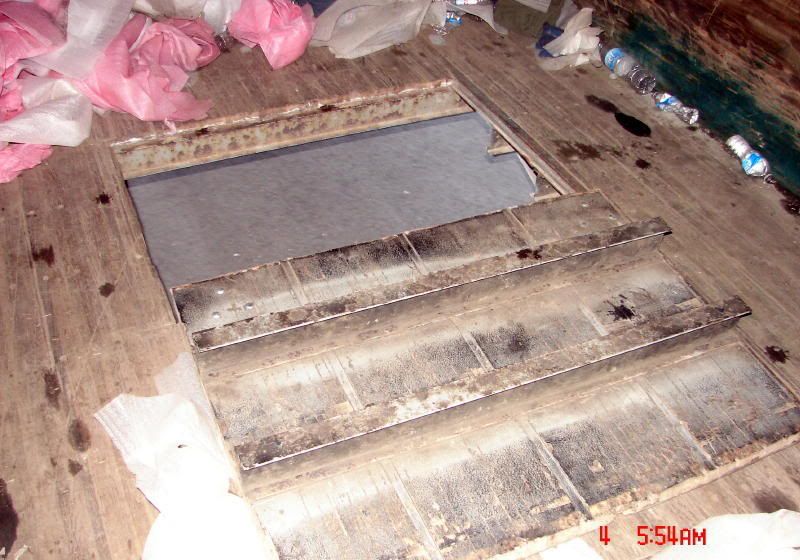
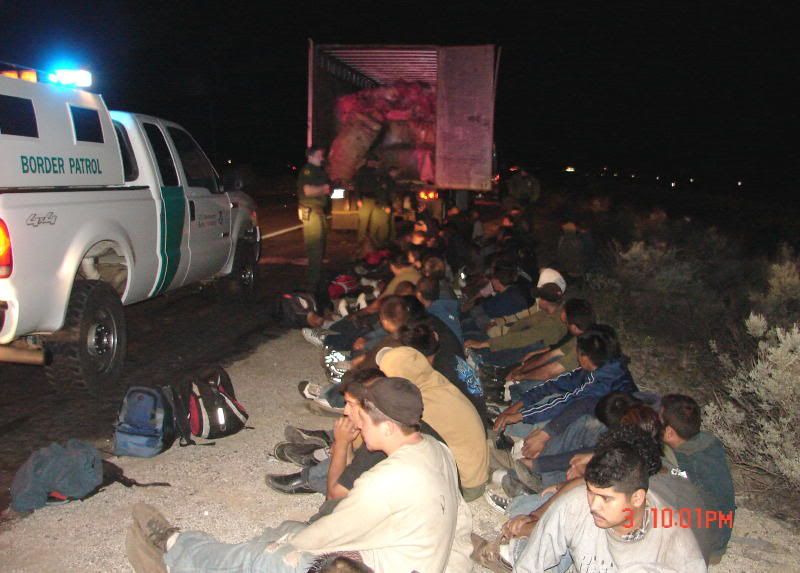
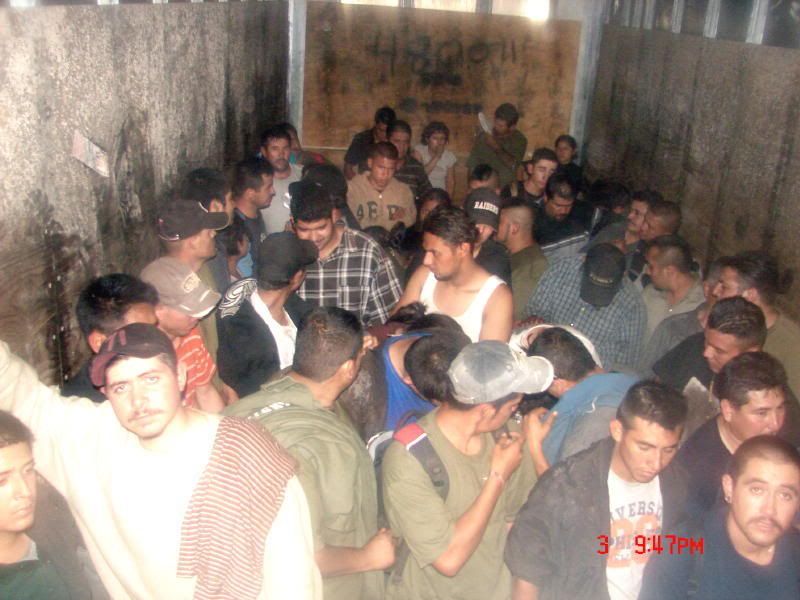



Sunday, May 4, 2008
Report from G - Man - 250 Apprehended to Date
Its been a while sense my last report, my year to date is now 250.
Nothing has changed, same thing different day. Its around 8:50 pm, just about time for the first group to come through. I'd better get going.
G Man
Nothing has changed, same thing different day. Its around 8:50 pm, just about time for the first group to come through. I'd better get going.
G Man
Subscribe to:
Posts (Atom)









